Characterizing the Impact of River Barrage Construction on Stream-Aquifer Interactions, Korea
Abstract
:1. Introduction
2. Materials and Methods
2.1. Study Area
2.2. Data Collection and Monitoring of Water Levels and Electrical Conductivity
2.3. Governing Equation for Stream-Aquifer Interactions
2.4. Removal of Noise from Groundwater Level Data with LPF
3. Results and Discussion
3.1. Changes in Water Levels and Electrical Conductivity
3.2. Evaluation of Stream–Aquifer Interactions by the Analytical Solution
3.2.1. Theoretical Curves Derived from the Analytical Solution
3.2.2. Selection of Flood Events and Changes in Their Characteristics
3.2.3. Removal of Noise Effects in Groundwater Level Data
3.2.4. Application of the Analytical Solution for Evaluating Stream–Aquifer Interactions
4. Conclusions
Acknowledgments
Author Contributions
Conflicts of Interest
References
- Illangasekare, T.; Morel-Seytoux, H.J. Stream-aquifer influence coefficients as tools for simulation and management. Water Resour. Res. 1982, 18, 168–176. [Google Scholar] [CrossRef]
- Sophocleous, M.; Koussis, A.; Martin, J.L.; Perkins, S.P. Evaluation of simplified stream-aquifer depletion models for water rights administration. Groundwater 1995, 33, 579–588. [Google Scholar] [CrossRef]
- Ray, C.; Soong, T.W.; Lian, Y.Q.; Roadcap, G.S. Effect of flood-induced chemical load on filtrate quality at bank filtration sites. J. Hydrol. 2002, 266, 235–258. [Google Scholar] [CrossRef]
- Chen, X.; Chen, X. Stream water infiltration, bank storage, and storage zone changes due to stream-stage fluctuations. J. Hydrol. 2003, 280, 246–264. [Google Scholar] [CrossRef]
- McCallum, J.L.; Cook, P.G.; Brunner, P.; Berhane, D. Solute dynamics during bank storage flows and implications for chemical base flow separation. Water Resour. Res. 2010, 46. [Google Scholar] [CrossRef]
- Pinder, G.F.; Bredehoeft, J.D.; Cooper, H.H. Determination of aquifer diffusivity from aquifer response to fluctuations in river stage. Water Resour. Res. 1969, 5, 850–855. [Google Scholar] [CrossRef]
- Reynolds, R.J. Diffusivity of glacial-outwash aquifer by the floodwave-response technique. Groundwater 1987, 25, 290–299. [Google Scholar] [CrossRef]
- Barlow, P.M.; DeSimone, L.A.; Moench, A.F. Aquifer response to stream-stage and recharge variations. II. Convolution method and applications. J. Hydrol. 2000, 230, 211–229. [Google Scholar] [CrossRef]
- Jha, M.K.; Jayalekshmi, K.; Machiwal, D.; Kamii, Y.; Chikamori, K. Determination of hydraulic parameters of an unconfined alluvial aquifer by the floodwave-response technique. Hydrogeol. J. 2004, 12, 628–642. [Google Scholar] [CrossRef]
- Ha, K.; Koh, D.C.; Yum, B.W.; Lee, K.K. Estimation of layered aquifer diffusivity and river resistance using flood wave response model. J. Hydrol. 2007, 337, 284–293. [Google Scholar] [CrossRef]
- Jung, M.; Burt, T.P.; Bates, P.D. Toward a conceptual model of floodplain water table response. Water Resour. Res. 2004, 40. [Google Scholar] [CrossRef]
- Hantush, M.M. Modeling stream–aquifer interactions with linear response functions. J. Hydrol. 2005, 311, 59–79. [Google Scholar] [CrossRef]
- Welch, C.; Harrington, G.A.; Leblanc, M.; Batlle-Aguilar, J.; Cook, P.G. Relative rates of solute and pressure propagation into heterogeneous alluvial aquifers following river flow events. J. Hydrol. 2014, 511, 891–903. [Google Scholar] [CrossRef]
- Welch, C.; Cook, P.G.; Harrington, G.A.; Robinson, N.I. Propagation of solutes and pressure into aquifers following river stage rise. Water Resour. Res. 2013, 49, 5246–5259. [Google Scholar] [CrossRef]
- Lewandowski, J.; Lischeid, G.; Nützmann, G. Drivers of water level fluctuations and hydrological exchange between groundwater and surface water at the lowland River Spree (Germany): Field study and statistical analyses. Hydrol. Process. 2009, 23, 2117–2128. [Google Scholar] [CrossRef]
- Burt, T.P.; Bates, P.D.; Stewart, M.D.; Claxton, A.J.; Anderson, M.G.; Price, D.A. Water table fluctuations within the floodplain of the River Severn, England. J. Hydrol. 2002, 262, 1–20. [Google Scholar] [CrossRef]
- Gillham, R.W. The capillary fringe and its effect on water-table response. J. Hydrol. 1984, 67, 307–324. [Google Scholar] [CrossRef]
- Kondolf, G.M. Hungry water: effects of dams and gravel mining on river channels. Environ. Manag. 1997, 21, 533–551. [Google Scholar] [CrossRef]
- Sawyer, A.H.; Cardenas, M.B.; Bomar, A.; Mackey, M. Impact of dam operations on hyporheic exchange in the riparian zone of a regulated river. Hydrol. Process. 2009, 23, 2129–2137. [Google Scholar] [CrossRef]
- Francis, B.A.; Francis, L.K.; Cardenas, M.B. Water table dynamics and groundwater–surface water interaction during filling and draining of a large fluvial island due to dam-induced river stage fluctuations. Water Resour. Res. 2010, 46. [Google Scholar] [CrossRef]
- Singh, S.K. Aquifer response to sinusoidal or arbitrary stage of semipervious stream. J. Hydraul. Eng. 2004, 130, 1108–1118. [Google Scholar] [CrossRef]
- Hall, F.R.; Moench, A.F. Application of the convolution equation to stream-aquifer relationships. Water Resour. Res. 1972, 8, 487–493. [Google Scholar] [CrossRef]
- Carslaw, H.S.; Jaeger, J.C. Conduction of Heat in Solids, 2nd ed.; Clarendon Press: Oxford, UK, 1959; pp. 50–127. [Google Scholar]
- Bruggeman, G.A. One-dimensional groundwater flow: Orientation table BI. Dev. Water Sci. 1999, 46, 77–78. [Google Scholar]
- Dong, L.; Cheng, D.; Liu, J.; Zhang, P.; Ding, W. Analytical analysis of groundwater responses to estuarine and oceanic water stage variations using superposition principle. J. Hydraul. Eng. 2016, 21, 04015046. [Google Scholar] [CrossRef]
- Cloutier, C.A.; Buffin-Bélanger, T.; Larocque, M. Controls of groundwater floodwave propagation in a gravelly floodplain. J. Hydrol. 2014, 511, 423–431. [Google Scholar] [CrossRef] [Green Version]
- García-Gil, A.; Vázquez-Suñé, E.; Sánchez-Navarro, J.Á.; Lázaro, J.M.; Alcaraz, M. The propagation of complex flood-induced head wavefronts through a heterogeneous alluvial aquifer and its applicability in groundwater flood risk management. J. Hydrol. 2015, 527, 402–419. [Google Scholar] [CrossRef]
- Zlotnik, V.A.; Huang, H. Effect of shallow penetration and streambed sediments on aquifer response to stream stage fluctuations (analytical model). Groundwater 1999, 37, 599–605. [Google Scholar] [CrossRef]
- Singh, V.P. Is hydrology kinematic? Hydrol. Process. 2002, 16, 667–716. [Google Scholar] [CrossRef]
- Vidon, P. Towards a better understanding of riparian zone water table response to precipitation: Surface water infiltration, hillslope contribution or pressure wave processes? Hydrol. Process. 2012, 26, 3207–3215. [Google Scholar] [CrossRef]
- Vekerdy, Z.; Meijerink, A.M.J. Statistical and analytical study of the propagation of flood-induced groundwater rise in an alluvial aquifer. J. Hydrol. 1998, 205, 112–125. [Google Scholar] [CrossRef]
- Barlow, J.R.; Coupe, R.H. Use of heat to estimate streambed fluxes during extreme hydrologic events. Water Resour. Res. 2009, 45, 1–10. [Google Scholar] [CrossRef]
- Sophocleous, M.A. Stream-floodwave propagation through the Great Bend alluvial aquifer, Kansas: Field measurements and numerical simulations. J. Hydrol. 1991, 124, 207–228. [Google Scholar] [CrossRef]
- Ministry of Land, Transportation, and Maritime Affairs (MLTM). The Detail Design of Development of Residential Sites for Nakdong River 18 District; MLTM: Seoul, Korea, 2009.
- Ministry of Land, Infrastructure, and Transport (MOLIT). Korea Annual Hydrological Report 2013; MOLIT: Seoul, Korea, 2013.
- National Climate Data Service System (NCDSS). Available online: http://sts.kma.go.kr/eng/jsp/home/contents/main/main.do (accessed on 29 September 2015).
- Choi, S.H.; Lyeo, S.C. National Geological Survey of Korea; Geological map of Namji Sheet (1:50000); National Geological Survey of Korea: Seoul, Korea, 1972; Sheet-6820-II. [Google Scholar]
- Kim, G.-B.; Cha, E.-J.; Jeong, H.-G.; Shin, K.-H. Comparison of time series of alluvial groundwater levels before and after barrage construction on the lower Nakdong River. J. Eng. Geol. 2013, 23, 105–115. (In Korean) [Google Scholar] [CrossRef]
- Hydronet Limited (Hydronet). The Report for the Installation of the Groundwater Observation Equipment; Hydronet Limited: Seoul, Korea, 2012; pp. 1–311. [Google Scholar]
- Spanoudaki, K.; Nanou-Giannarou, A.; Paschalinos, Y.; Memos, C.D.; Atamou, A.I. Analytical solutions to the stream-aquifer interaction problem: A critical review. Global NEST J. 2010, 12, 126–139. [Google Scholar]
- Hantush, M.S. Wells near streams with semipervious beds. J. Geophys. Res. 1965, 70, 2829–2838. [Google Scholar] [CrossRef]
- Cooper, H.H.; Rorabaugh, M.I. Ground-water Movements and Bank Storage Due to Flood Stages in Surface Streams; U.S. Government Printing Office: Washington, DC, USA, 1963; pp. 343–366.
- Hantush, M.S. Discussion of paper by P.P. Rowe, An equation for estimating transmissibility and coefficient of storage from river-level fluctuations. J. Geophys. Res. 1961, 66, 1310–1311. [Google Scholar] [CrossRef]
- Ferris, J.G. Cyclic fluctuations of water level as a basis for determining aquifer transmissibility. Assemblee Generale Bruxelles Ass. Int. Hydrol. Sci. 1951, 2, 148–155. [Google Scholar]
- Bentall, R. Methods of Determining Permeability, Transmissibility and Drawdown; USGS Water Supply Paper 1536-I; United States Government Printing Office: Washington, DC, USA, 1964; p. 99.
- Spongberg, M.E. Spectral analysis of base flow separation with digital filters. Water Resour. Res. 2000, 36, 745–752. [Google Scholar] [CrossRef]
- Walker, J.S. Fast Fourier Transforms, 2nd ed.; CRC Press: Boca Raton, FL, USA, 1996; pp. 58–76. [Google Scholar]
- Jacob, C.E. Flow of Groundwater in Engineering Hydraulics; Rouse, H., Ed.; John Wiley: New York, NY, USA, 1950; pp. 321–386. [Google Scholar]
- Carr, P.A.; Van Der Kamp, G.S. Determining aquifer characteristics by the tidal method. Water Resour. Res. 1969, 5, 1023–1031. [Google Scholar] [CrossRef]
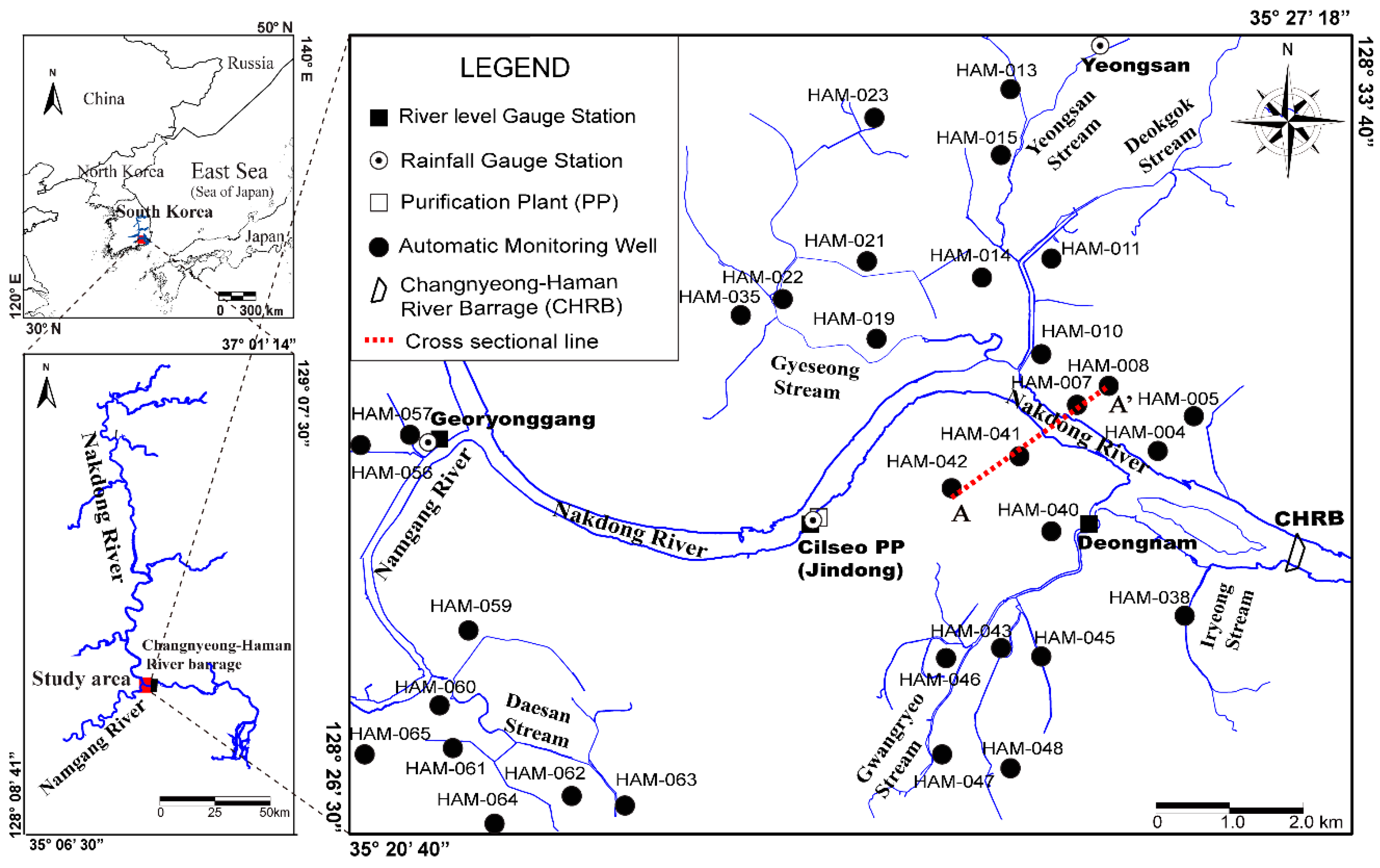
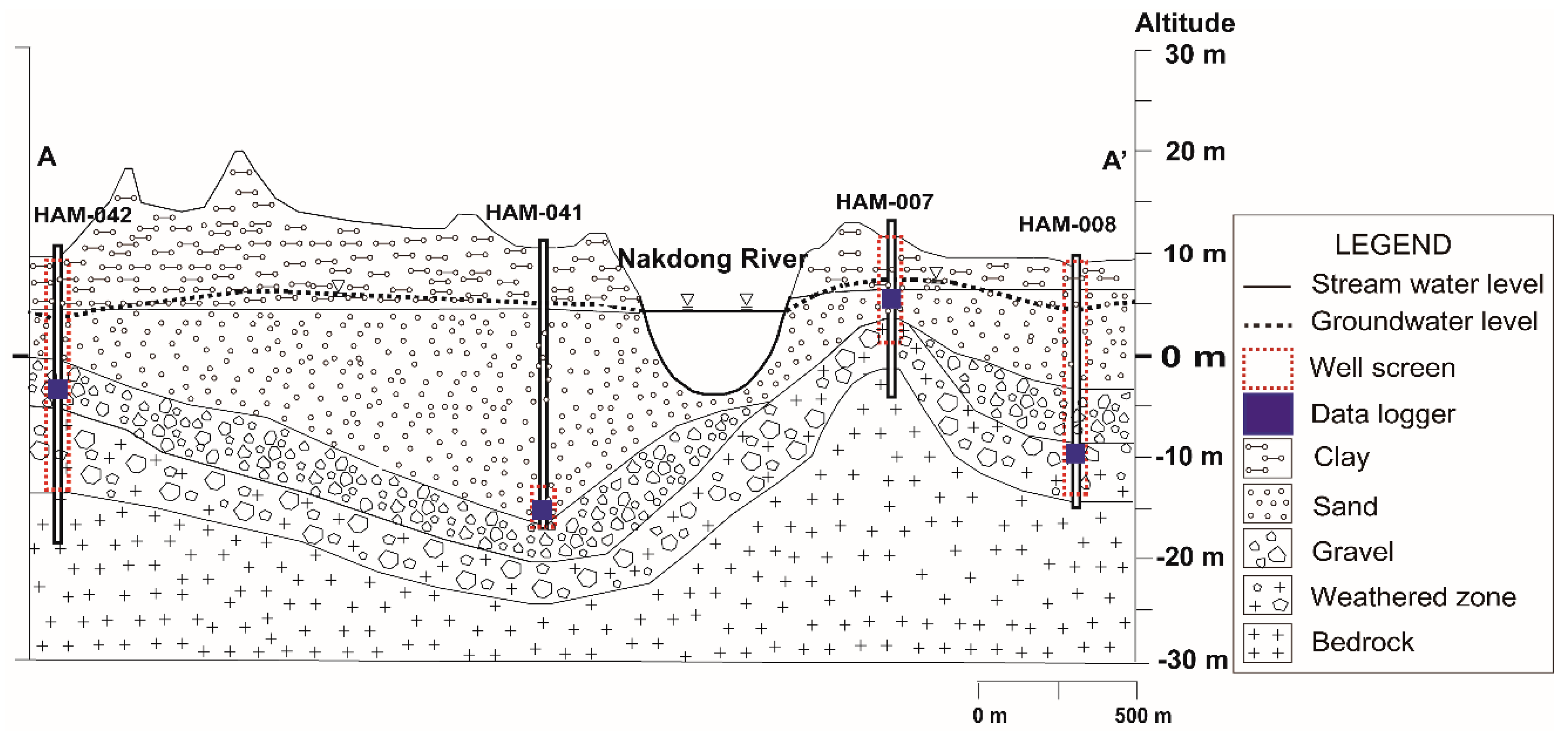
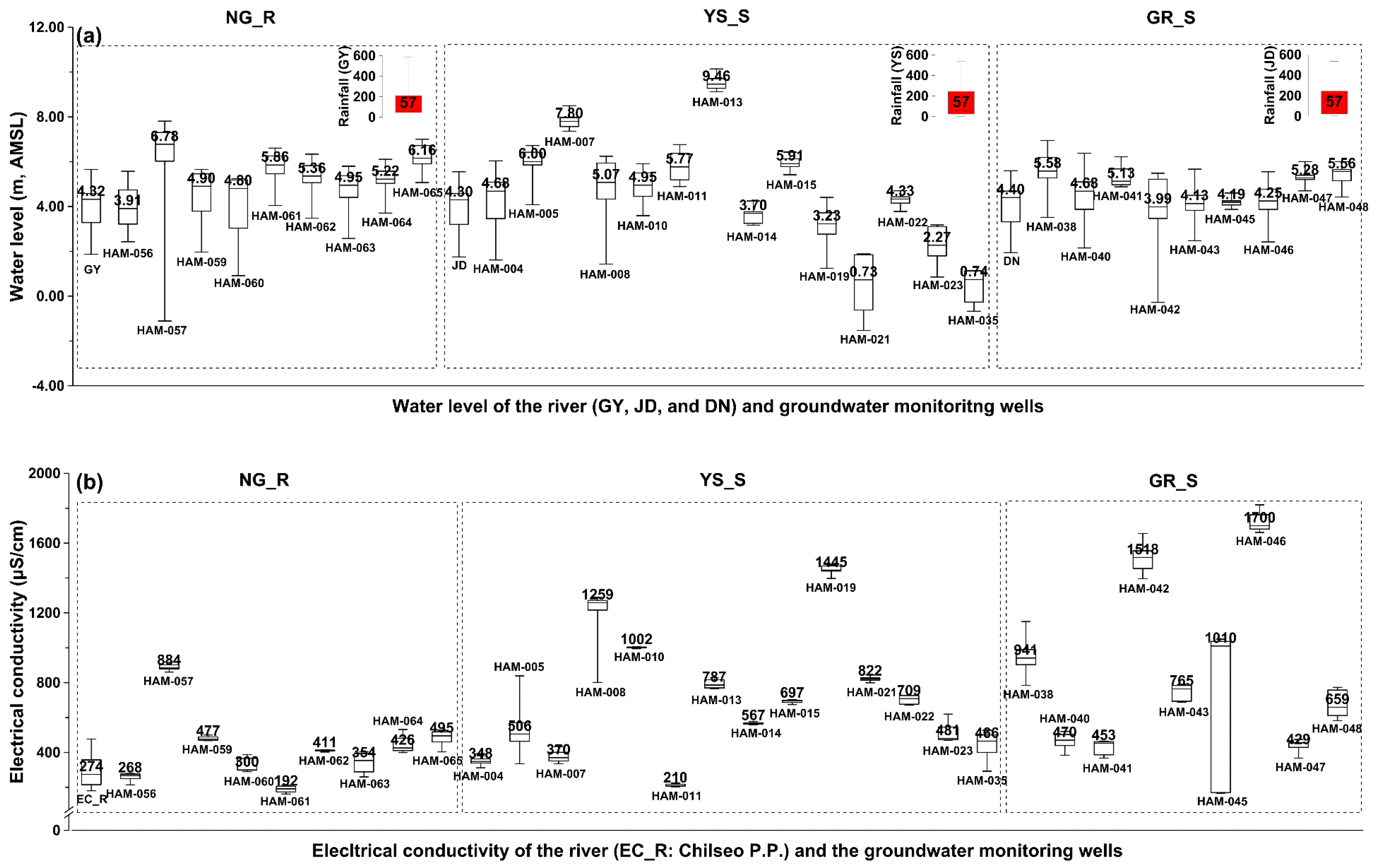
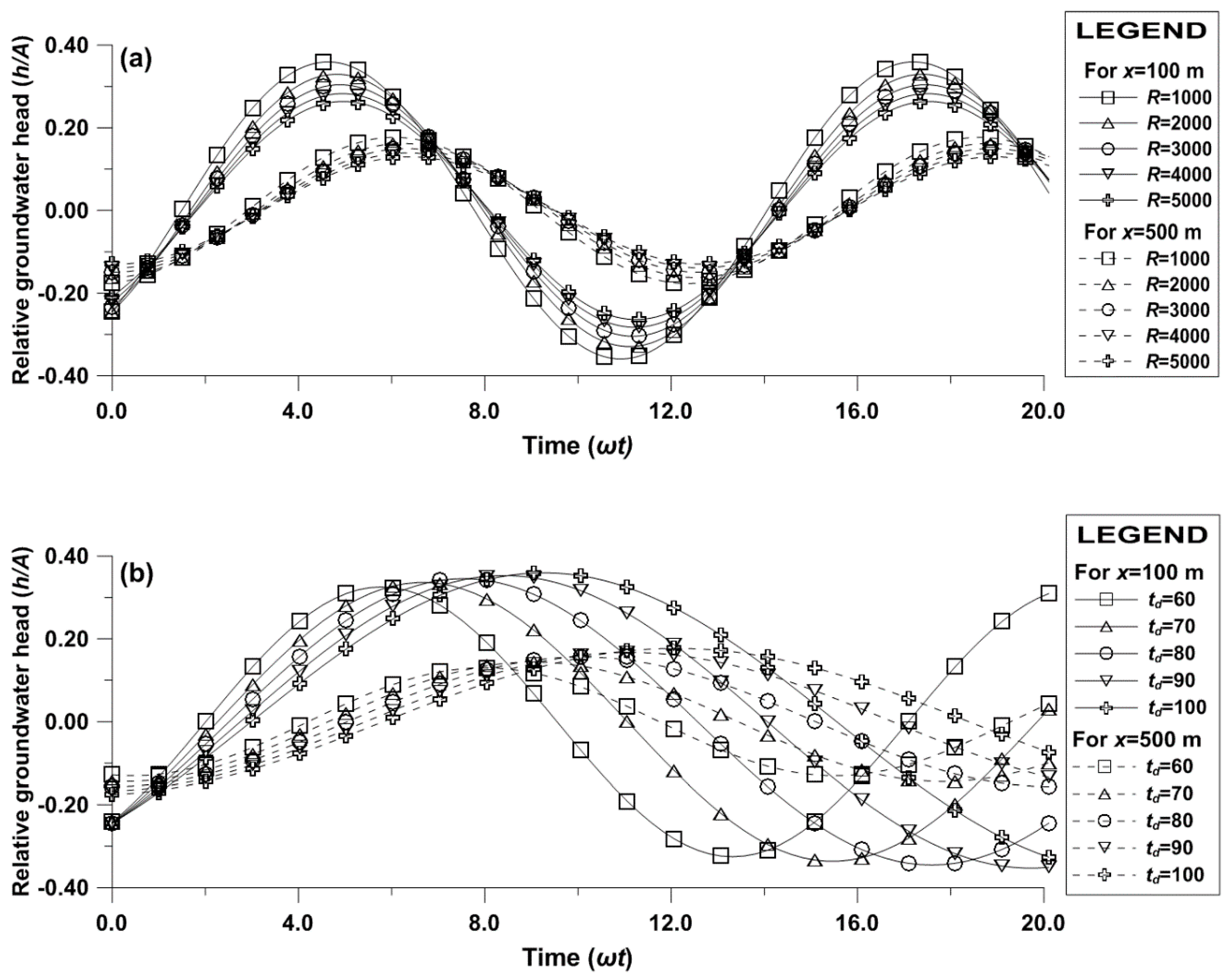
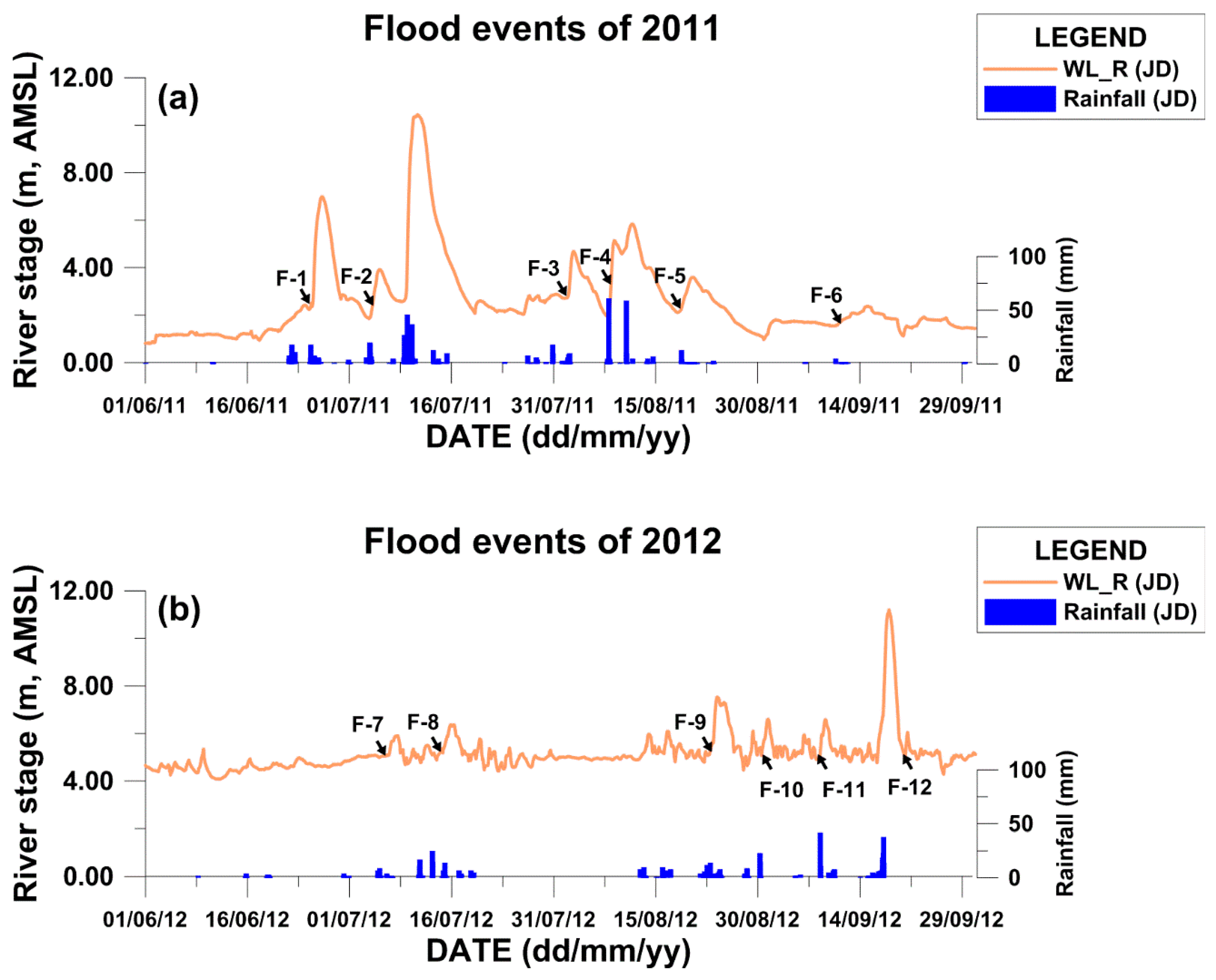
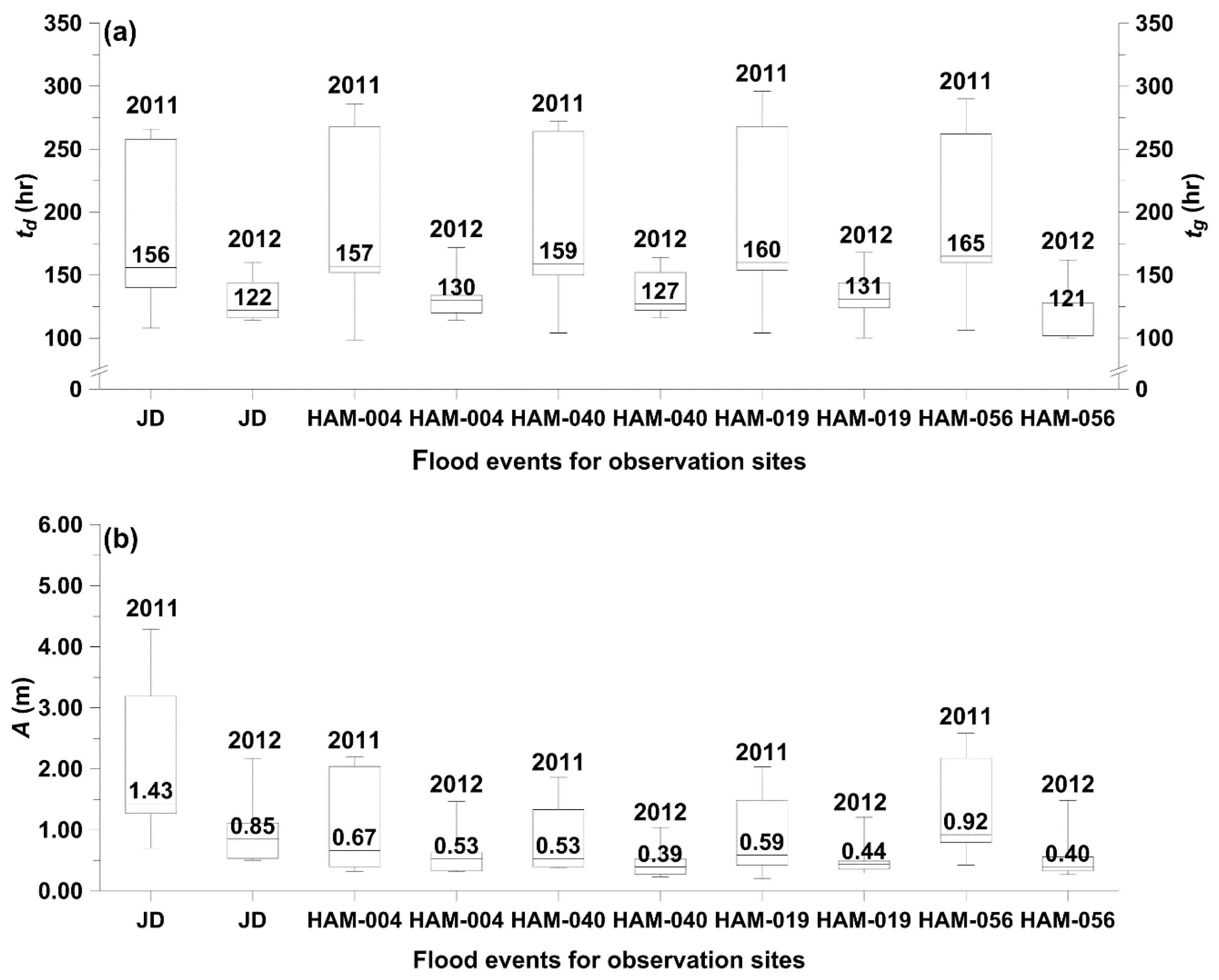


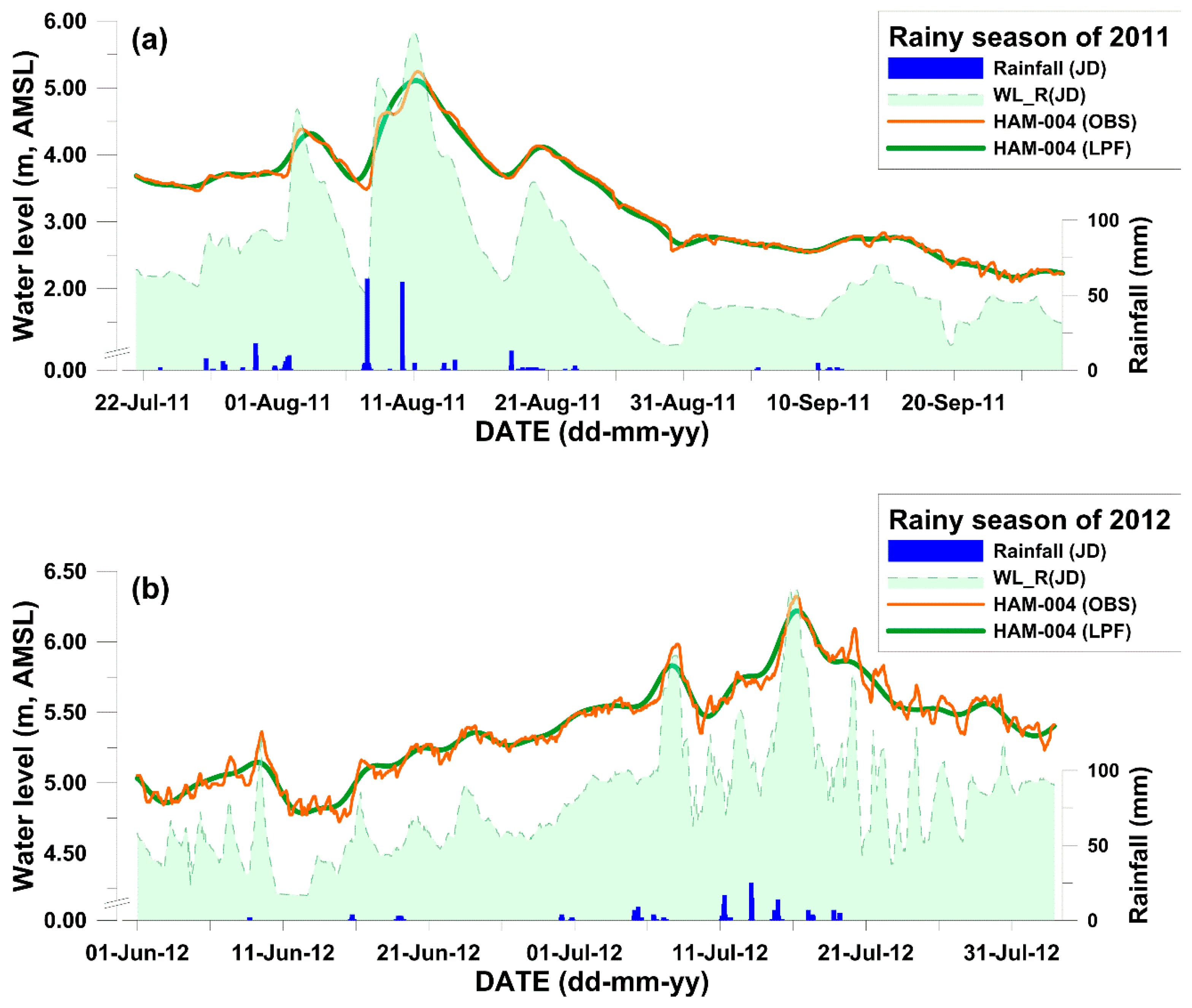
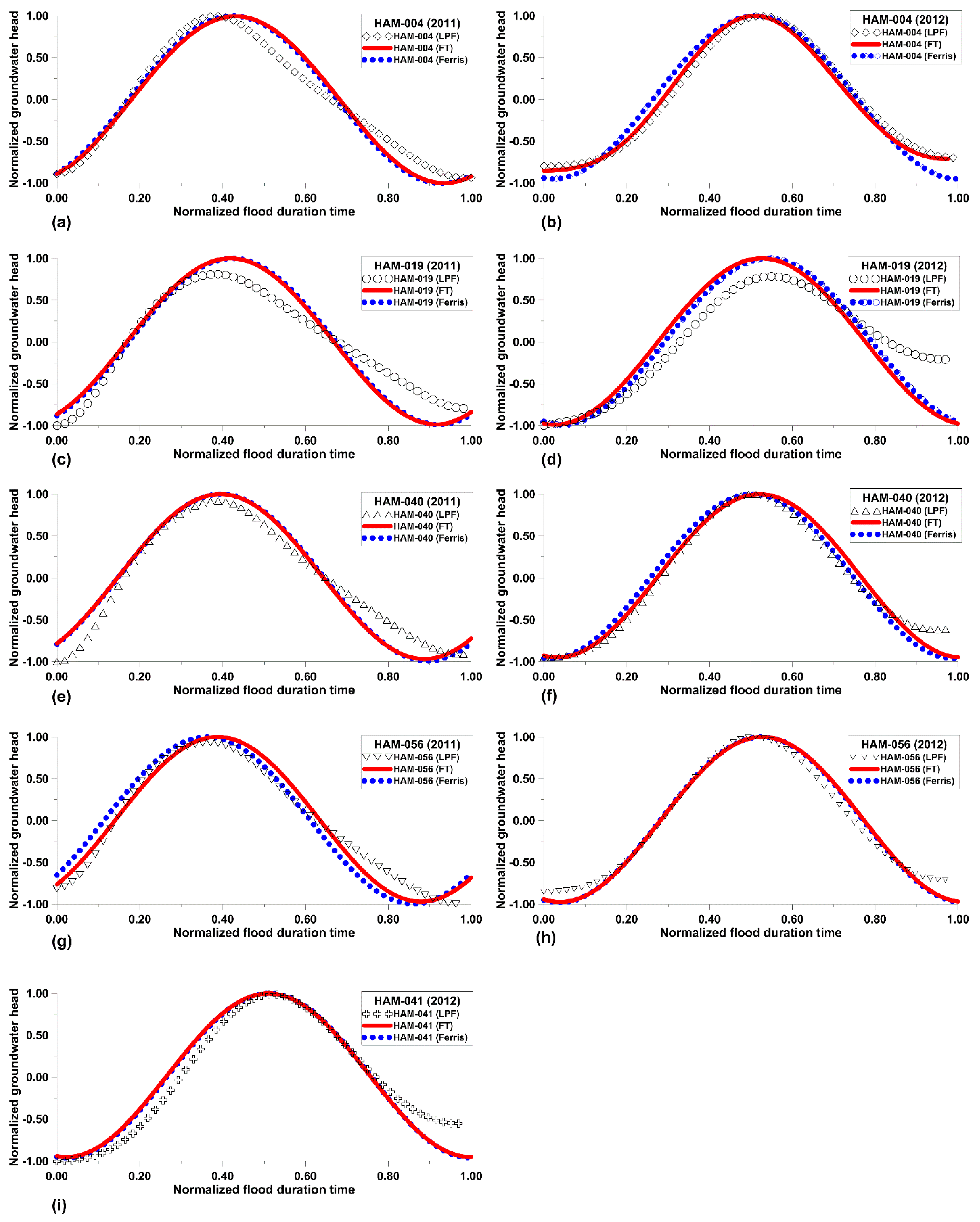
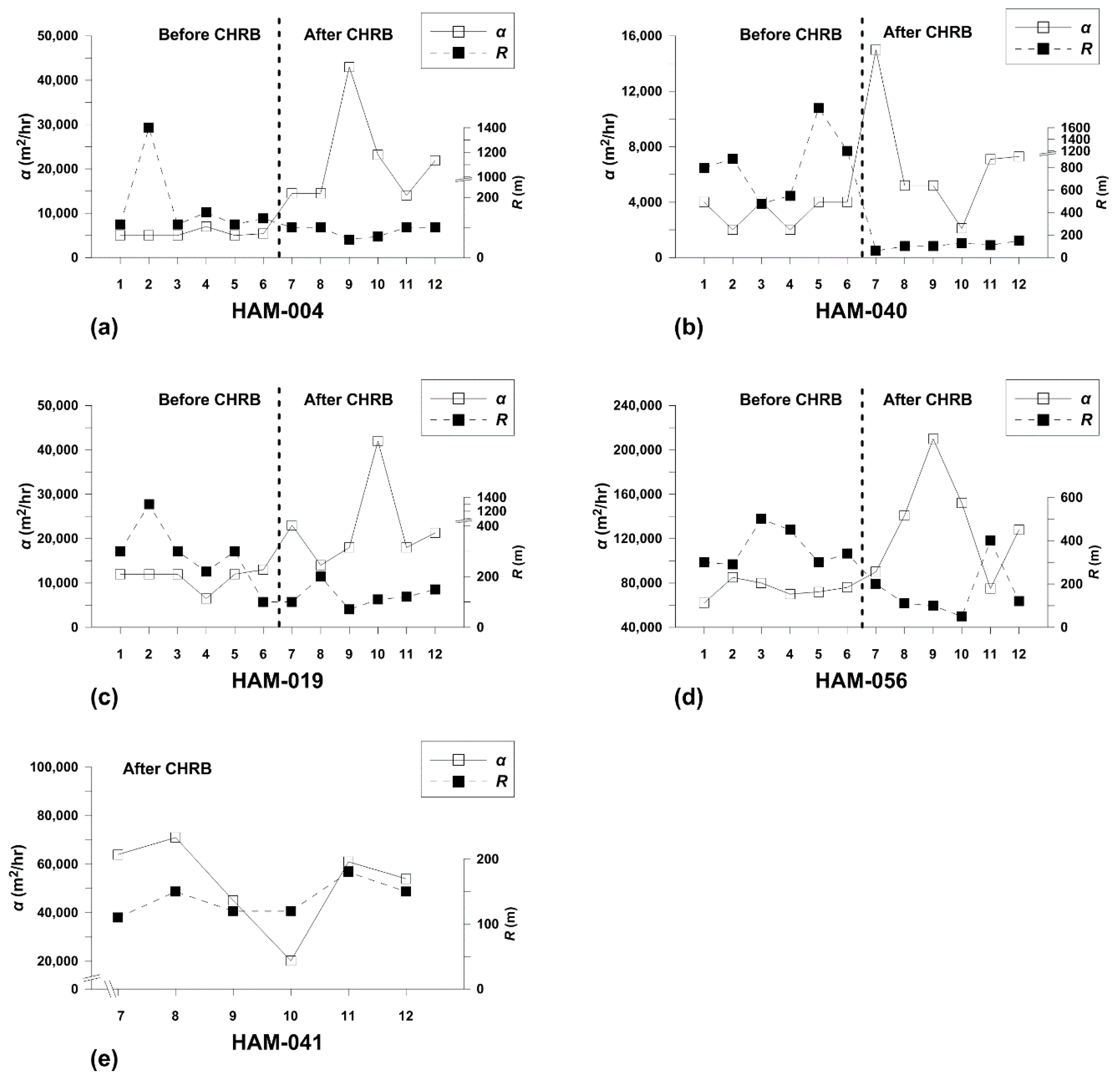
| Data | Unit | Location | Observation Period |
|---|---|---|---|
| Rainfall | mm | Yeongsan (in YS_S), Jindong (in GR_S), and Georyonggang (in NG_R) rainfall gauge stations | June 2011–February 2013 |
| WL_R | m (AMSL) | Deongnam (in YS_S), Jingdong (in GR_S), and Georyonggang (in NG_R) gauge stations | |
| Electrical conductivity of river water (EC_R) | µS/cm | Chilseo purification plant (with the Jingdong gauge station) | July 2012–February 2013 |
| Groundwater level (WL_G) and Electrical conductivity (EC_G) | m (AMSL) and µS/cm | HAM-004, 005, 007, 008, 010, 013, 019, 022 (in YS_S), 038, 040, 042, 043, 046 (in GR_S), 056, 057, 059 (in NG_R) | June 2011–February 2013 |
| HAM-014, 015, 021, 023, 035 (in YS_S), 045, 047, 048 (in GR_S), 060, 061, 062, 063, 064, 065 (in NG_R) | June 2012–February 2013 |
| Year/Season | Before the River Barrage | After the River Barrage | ||
|---|---|---|---|---|
| 2011 | 2012 | |||
| Rainy (June–September) | Dry (November–Februaty) | Rainy (June–September) | Dry (November–February) | |
| Rainfall (mm) | 1018 | 125 | 862 | 175 |
| WL_R (m, AMSL) | 2.58 | 3.29 | 5.15 | 4.46 |
| Fluctuation of WL_R (max–min. m) | 9.50 | 2.29 | 7.12 | 1.48 |
| WL_G (m, AMSL) | 4.64 | 5.03 | 5.40 | 4.88 |
| Average differences of WL_R (m) | 1.87 | |||
| Fluctuation of WL_G (m) (max–min, m) | 12.30 | 8.15 | 13.75 | 9.74 |
| Average differences of WL_R fluctuation (m) | 1.60 | |||
| EC_R (µS/cm) | - | - | 370 | 262 |
| Fluctuation of EC_R (max–min, µS/cm) | - | - | 549 | 322 |
| EC_G (µS/cm) | 675 | 670 | 680 | 650 |
| Fluctuation of EC_G (max–min, µS/cm) | 1404 | 2351 | 1709 | 1544 |
| Observation Point | Factors of Observation Points | Flood Events (F-1 to F-12) in June–September | |||
|---|---|---|---|---|---|
| F-1 to F-6 in 2011 | F-7 to F-12 in 2012 | ||||
| FT | Ferris (1951) [44] | FT | Ferris (1951) [44] | ||
| Jindong (JD) | td (h) | 181 | 130 | ||
| tp (h) | 83 | 57 | |||
| A (m) | 2.05 | 0.54 | |||
| HAM-004 | tg (h) | 186 | 133 | ||
| tip (h)/tlag (h) | 106/23 | 62/5 | |||
| A (m) | 1.05 | 0.63 | |||
| x (m) | 300 | ||||
| T (m2/h)/K (m/s) | 1.22 × 10−2/8.68 × 10−8 | ||||
| α (m2/h) | 5400 | 3980 | 21,850 | 16,850 | |
| R (m) | 335 | - | 88 | - | |
| HAM-019 | tg (h) | 190 | 133 | ||
| tip (h)/tlag (h) | 101/18 | 65/9 | |||
| A (m) | 0.84 | 0.48 | |||
| x (m) | 600 | ||||
| T (m2/h)/K (m/s) | 3.73 × 10−1/3.91 × 10−6 | ||||
| α (m2/h) | 11,250 | 9300 | 22,717 | 19,850 | |
| R (m) | 420 | - | 125 | - | |
| HAM-040 | tg (hr) | 185 | 135 | ||
| tip (h)/tlag (h) | 97/14 | 63/6 | |||
| A (m) | 0.89 | 0.54 | |||
| x (m) | 250 | ||||
| T (m2/h)/K (m/s) | 4.52 × 10−2/4.18 × 10−7 | ||||
| α (m2/h) | 3333 | 2045 | 6983 | 5357 | |
| R (m) | 975 | - | 108 | - | |
| HAM-041 | tg (h) | - | 128 | ||
| tip (h)/tlag (h) | - | 70/13 | |||
| A (m) | - | 0.52 | |||
| x (m) | 800 | ||||
| T (m2/h)/K (m/s) | 4.67 × 10−1/5.13 × 10−6 | ||||
| α (m2/h) | - | - | 52,533 | 46,350 | |
| R (m) | - | - | 138 | - | |
| HAM-056 | tg (h) | 191 | 122 | ||
| tip (h)/tlag (h) | 91/8 | 63/7 | |||
| A (m) | 1.30 | 0.57 | |||
| x (m) | 850 | ||||
| T (m2/h)/K (m/s) | 1.84 × 10−2/1.50 × 10−7 | ||||
| α (m2/h) | 74,167 | 67,566 | 132,667 | 114,917 | |
| R (m) | 363 | - | 163 | - | |
© 2016 by the authors; licensee MDPI, Basel, Switzerland. This article is an open access article distributed under the terms and conditions of the Creative Commons by Attribution (CC-BY) license (http://creativecommons.org/licenses/by/4.0/).
Share and Cite
Oh, Y.-Y.; Hamm, S.-Y.; Ha, K.; Yoon, H.; Chung, I.-M. Characterizing the Impact of River Barrage Construction on Stream-Aquifer Interactions, Korea. Water 2016, 8, 137. https://doi.org/10.3390/w8040137
Oh Y-Y, Hamm S-Y, Ha K, Yoon H, Chung I-M. Characterizing the Impact of River Barrage Construction on Stream-Aquifer Interactions, Korea. Water. 2016; 8(4):137. https://doi.org/10.3390/w8040137
Chicago/Turabian StyleOh, Yun-Yeong, Se-Yeong Hamm, Kyoochul Ha, Heesung Yoon, and Il-Moon Chung. 2016. "Characterizing the Impact of River Barrage Construction on Stream-Aquifer Interactions, Korea" Water 8, no. 4: 137. https://doi.org/10.3390/w8040137
APA StyleOh, Y.-Y., Hamm, S.-Y., Ha, K., Yoon, H., & Chung, I.-M. (2016). Characterizing the Impact of River Barrage Construction on Stream-Aquifer Interactions, Korea. Water, 8(4), 137. https://doi.org/10.3390/w8040137








